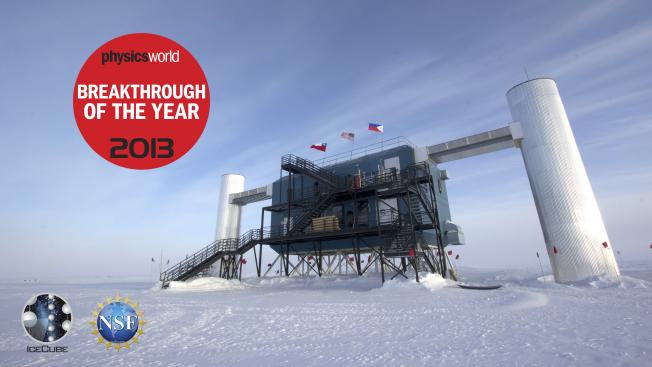Erratum: IceCube sensitivity for low-energy neutrinos from nearby supernovae(Astronomy and Astrophysics (2011) 535 : A109 (DOI: 10.1051/0004-6361/201117810))
Astronomy and Astrophysics 563 (2014)
IceCube search for dark matter annihilation in nearby galaxies and galaxy clusters
Physical Review D - Particles, Fields, Gravitation and Cosmology 88:12 (2013)
Abstract:
We present the results of a first search for self-annihilating dark matter in nearby galaxies and galaxy clusters using a sample of high-energy neutrinos acquired in 339.8 days of live time during 2009/10 with the IceCube neutrino observatory in its 59-string configuration. The targets of interest include the Virgo and Coma galaxy clusters, the Andromeda galaxy, and several dwarf galaxies. We obtain upper limits on the cross section as a function of the weakly interacting massive particle mass between 300 GeV and 100 TeV for the annihilation into bb̄, W+W-, τ+τ -, μ+μ-, and νν̄. A limit derived for the Virgo cluster, when assuming a large effect from subhalos, challenges the weakly interacting massive particle interpretation of a recently observed GeV positron excess in cosmic rays. © 2013 American Physical Society.Search for neutrino-induced particle showers with IceCube-40
ArXiv 1312.0104 (2013)
Abstract:
We report on the search for neutrino-induced particle-showers, so-called cascades, in the IceCube-40 detector. The data for this search was collected between April 2008 and May 2009 when the first 40 IceCube strings were deployed and operational. Three complementary searches were performed, each optimized for different energy regimes. The analysis with the lowest energy threshold (2 TeV) targeted atmospheric neutrinos. A total of 67 events were found, consistent with the expectation of 41 atmospheric muons and 30 atmospheric neutrino events. The two other analyses targeted a harder, astrophysical neutrino flux. The analysis with an intermediate threshold of 25 TeV lead to the observation of 14 cascade-like events, again consistent with the prediction of 3.0 atmospheric neutrino and 7.7 atmospheric muon events. We hence set an upper limit of $E^2 \Phi_{lim} \leq 7.46\times10^{-8}\,\mathrm{GeV sr^{-1} s^{-1} cm^{-2}}$ (90% C.L.) on the diffuse flux from astrophysical neutrinos of all neutrino flavors, applicable to the energy range 25 TeV to 5 PeV, assuming an $E_{\nu}^{-2}$ spectrum and a neutrino flavor ratio of 1:1:1 at the Earth. The third analysis utilized a larger and optimized sample of atmospheric muon background simulation, leading to a higher energy threshold of 100 TeV. Three events were found over a background prediction of 0.04 atmospheric muon events and 0.21 events from the flux of conventional and prompt atmospheric neutrinos. Including systematic errors this corresponds to a $2.7\sigma$ excess with respect to the background-only hypothesis. Our observation of neutrino event candidates above 100 TeV complements IceCube's recently observed evidence for high-energy astrophysical neutrinos.The IceProd Framework: Distributed Data Processing for the IceCube Neutrino Observatory
ArXiv 1311.5904 (2013)
Abstract:
IceCube is a one-gigaton instrument located at the geographic South Pole, designed to detect cosmic neutrinos, iden- tify the particle nature of dark matter, and study high-energy neutrinos themselves. Simulation of the IceCube detector and processing of data require a significant amount of computational resources. IceProd is a distributed management system based on Python, XML-RPC and GridFTP. It is driven by a central database in order to coordinate and admin- ister production of simulations and processing of data produced by the IceCube detector. IceProd runs as a separate layer on top of other middleware and can take advantage of a variety of computing resources, including grids and batch systems such as CREAM, Condor, and PBS. This is accomplished by a set of dedicated daemons that process job submission in a coordinated fashion through the use of middleware plugins that serve to abstract the details of job submission and job management from the framework.Energy Reconstruction Methods in the IceCube Neutrino Telescope
ArXiv 1311.4767 (2013)



